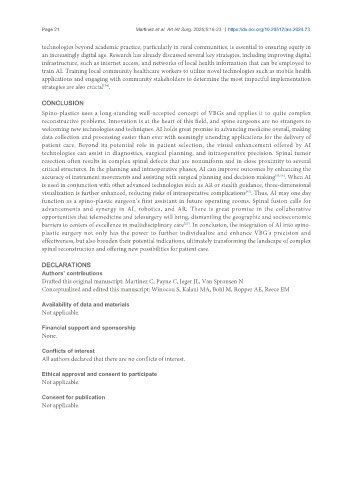Page 104 - Read Online
P. 104
Page 21 Martinez et al. Art Int Surg. 2025;5:16-23 https://dx.doi.org/10.20517/ais.2024.73
technologies beyond academic practice, particularly in rural communities, is essential to ensuring equity in
an increasingly digital age. Research has already discussed several key strategies, including improving digital
infrastructure, such as internet access, and networks of local health information that can be employed to
train AI. Training local community healthcare workers to utilize novel technologies such as mobile health
applications and engaging with community stakeholders to determine the most impactful implementation
[54]
strategies are also crucial .
CONCLUSION
Spino-plastics uses a long-standing well-accepted concept of VBGs and applies it to quite complex
reconstructive problems. Innovation is at the heart of this field, and spine surgeons are no strangers to
welcoming new technologies and techniques. AI holds great promise in advancing medicine overall, making
data collection and processing easier than ever with seemingly unending applications for the delivery of
patient care. Beyond its potential role in patient selection, the visual enhancement offered by AI
technologies can assist in diagnostics, surgical planning, and intraoperative precision. Spinal tumor
resection often results in complex spinal defects that are nonuniform and in close proximity to several
critical structures. In the planning and intraoperative phases, AI can improve outcomes by enhancing the
accuracy of instrument movements and assisting with surgical planning and decision making [55,56] . When AI
is used in conjunction with other advanced technologies such as AR or stealth guidance, three-dimensional
visualization is further enhanced, reducing risks of intraoperative complications . Thus, AI may one day
[45]
function as a spino-plastic surgeon’s first assistant in future operating rooms. Spinal fusion calls for
advancements and synergy in AI, robotics, and AR. There is great promise in the collaborative
opportunities that telemedicine and telesurgery will bring, dismantling the geographic and socioeconomic
[25]
barriers to centers of excellence in multidisciplinary care . In conclusion, the integration of AI into spino-
plastic surgery not only has the power to further individualize and enhance VBG’s precision and
effectiveness, but also broaden their potential indications, ultimately transforming the landscape of complex
spinal reconstruction and offering new possibilities for patient care.
DECLARATIONS
Authors’ contributions
Drafted this original manuscript: Martinez C, Payne C, Jeger JL, Van Spronsen N
Conceptualized and edited this manuscript: Winocou S, Kalani MA, Bohl M, Ropper AE, Reece EM
Availability of data and materials
Not applicable.
Financial support and sponsorship
None.
Conflicts of interest
All authors declared that there are no conflicts of interest.
Ethical approval and consent to participate
Not applicable.
Consent for publication
Not applicable.

